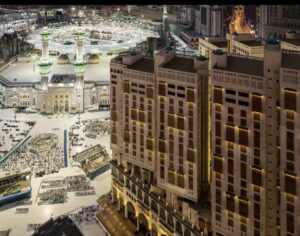Saudi Arabia was known before as Jaziratul Arab. This is the old name of Saudi Arabia.

In the pre-Islamic period, Arabia was the first of Jazirat al-Arab or Arabian-peninsula Arabia and the Arab-nation Habitat—The matter is historically proven. The Arabian Peninsula is spread over different regions. The island is surrounded by sea on three sides. It is geographically bounded by the Arabian Sea to the south, Iraq and Syria to the north, the Arabian (or Persian) Gulf to the east, and the Red Sea to the west.
Even before Islam, the Arabs did not deny the monotheism of Allah; Rather, even though they committed shirk, they believed that God exists as the creator.
At that time, among the Arab tribes in Makkah, the Quraysh were the only peaceful and conflict-free tribe. Because, there was an advisory committee among them. A small parliament and meeting place called ‘Darun Nadwa’ – where they consulted on various issues.
Islam occupies a place of superiority and priority over other religions of the world due to its various characteristics and uniqueness. Just as this religion makes man’s relationship with the Lord well formed and strengthened, so also the brotherly relationship of man with man is regularized and strengthened— Similarly, Islam consolidates the relationship between the individual and the state. Due to the application and laws of Islam, this religion is regarded as an international system and law.
Respecting the Haram Sharif Since the time of Prophet Ibrahim, the Arabs have had a tradition of respecting and valuing the Haram area around the Kaaba Sharif. The Arabs agreed on the illegality of fighting or murder within the boundaries of the Haram. Therefore, whoever enters the Haram Sharif, no harm will be done to him until he exits it safely – in this matter they were diligent. The Arabs had an admirable custom during the Jahili period; They respected and valued it enough.
What should be understood and realized is that the Muslims did not enter their conquered lands and territories as warriors and invaders; rather
They entered these countries as soldiers to spread the eternal message of Islam and civilization-culture. In the awakening of different races and peoples or
Islamic civilization and culture played a major role in the renaissance.
The family system can be observed among them from the beginning of Arab-nation. The family system was created through the marriage of men and women. Then the family gradually expanded through progeny.
Two of the most characteristic qualities of the Arabs of that time — generosity and charity. Generosity becomes part of the common demeanor and behavior in their society. Every person in the society competes in this. —Who can be more generous than whom? No one can disagree that generosity is one of their virtues.
A brilliant example of Arab engineering and planning was the Bedouin’s keen knowledge of weather fluctuations and rain forecasting at the Marib Dam in Yemen. They could predict the rain with such precision by watching the movement of the wind that at various times they would order their subordinates to leave the valley and move elsewhere. Because they could understand, at that time, a heavy downpour would descend in the valley.
Since ancient times Arab-nation have been familiar and close to trade. Despite living a nomadic life, they were quite advanced in trade and commerce. Besides, the geographical location of the Arabian Peninsula also boosted their commercial activities.
The southern ports of the Arabian Peninsula carry cargo from the Far East and India would come. They later moved to various ports and Western European countries. In addition to this, several Arab townspeople sell local goods abroad. He used to earn foreign currency by exporting.
In September 1932, a new era of Saudi Arabia began in the Arabian Peninsula with the issuance of a royal decree by Prince Abdul Aziz. Renaissance in the era of Prince Abdul Aziz Prince Abdul Aziz revived the great reform movement. Be active in the formation of the state by the manpower of the country and abroad. He developed close relations with Arab and Islamic countries.
The security of the country is strengthened by applying the provisions of Quran and Islamic law. Caste and tribal conflicts are eliminated. Haramain’s Hajj activities are kept safe. Villages were built to stabilize the Bedouin. Schools and hospitals were established.
In this way, Prince Abdul Aziz Al Saud succeeded in rebuilding Saudi Arabia based on the principles of Islamic law and modern renaissance in the light of his deep faith, knowledge and wisdom. This ruler passed away in 1953 on November 9, 1973.
